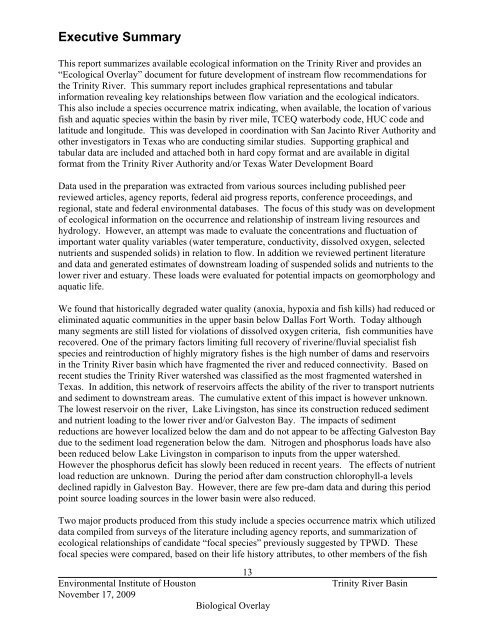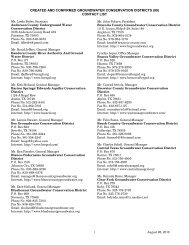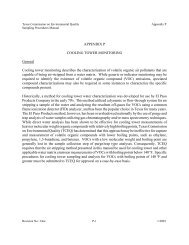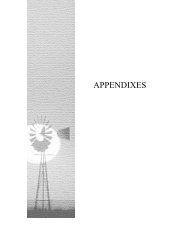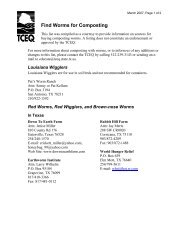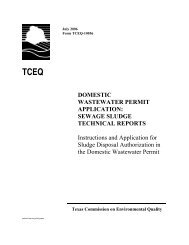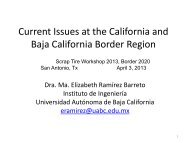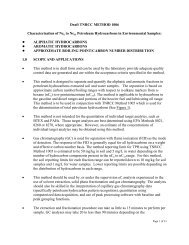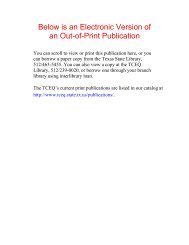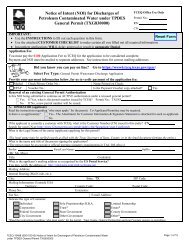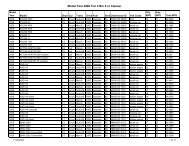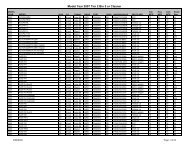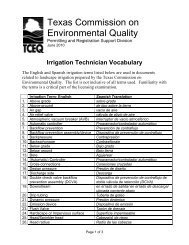Ecological Overlay for the Trinity River for support of Development of ...
Ecological Overlay for the Trinity River for support of Development of ...
Ecological Overlay for the Trinity River for support of Development of ...
Create successful ePaper yourself
Turn your PDF publications into a flip-book with our unique Google optimized e-Paper software.
Executive Summary<br />
This report summarizes available ecological in<strong>for</strong>mation on <strong>the</strong> <strong>Trinity</strong> <strong>River</strong> and provides an<br />
“<strong>Ecological</strong> <strong>Overlay</strong>” document <strong>for</strong> future development <strong>of</strong> instream flow recommendations <strong>for</strong><br />
<strong>the</strong> <strong>Trinity</strong> <strong>River</strong>. This summary report includes graphical representations and tabular<br />
in<strong>for</strong>mation revealing key relationships between flow variation and <strong>the</strong> ecological indicators.<br />
This also include a species occurrence matrix indicating, when available, <strong>the</strong> location <strong>of</strong> various<br />
fish and aquatic species within <strong>the</strong> basin by river mile, TCEQ waterbody code, HUC code and<br />
latitude and longitude. This was developed in coordination with San Jacinto <strong>River</strong> Authority and<br />
o<strong>the</strong>r investigators in Texas who are conducting similar studies. Supporting graphical and<br />
tabular data are included and attached both in hard copy <strong>for</strong>mat and are available in digital<br />
<strong>for</strong>mat from <strong>the</strong> <strong>Trinity</strong> <strong>River</strong> Authority and/or Texas Water <strong>Development</strong> Board<br />
Data used in <strong>the</strong> preparation was extracted from various sources including published peer<br />
reviewed articles, agency reports, federal aid progress reports, conference proceedings, and<br />
regional, state and federal environmental databases. The focus <strong>of</strong> this study was on development<br />
<strong>of</strong> ecological in<strong>for</strong>mation on <strong>the</strong> occurrence and relationship <strong>of</strong> instream living resources and<br />
hydrology. However, an attempt was made to evaluate <strong>the</strong> concentrations and fluctuation <strong>of</strong><br />
important water quality variables (water temperature, conductivity, dissolved oxygen, selected<br />
nutrients and suspended solids) in relation to flow. In addition we reviewed pertinent literature<br />
and data and generated estimates <strong>of</strong> downstream loading <strong>of</strong> suspended solids and nutrients to <strong>the</strong><br />
lower river and estuary. These loads were evaluated <strong>for</strong> potential impacts on geomorphology and<br />
aquatic life.<br />
We found that historically degraded water quality (anoxia, hypoxia and fish kills) had reduced or<br />
eliminated aquatic communities in <strong>the</strong> upper basin below Dallas Fort Worth. Today although<br />
many segments are still listed <strong>for</strong> violations <strong>of</strong> dissolved oxygen criteria, fish communities have<br />
recovered. One <strong>of</strong> <strong>the</strong> primary factors limiting full recovery <strong>of</strong> riverine/fluvial specialist fish<br />
species and reintroduction <strong>of</strong> highly migratory fishes is <strong>the</strong> high number <strong>of</strong> dams and reservoirs<br />
in <strong>the</strong> <strong>Trinity</strong> <strong>River</strong> basin which have fragmented <strong>the</strong> river and reduced connectivity. Based on<br />
recent studies <strong>the</strong> <strong>Trinity</strong> <strong>River</strong> watershed was classified as <strong>the</strong> most fragmented watershed in<br />
Texas. In addition, this network <strong>of</strong> reservoirs affects <strong>the</strong> ability <strong>of</strong> <strong>the</strong> river to transport nutrients<br />
and sediment to downstream areas. The cumulative extent <strong>of</strong> this impact is however unknown.<br />
The lowest reservoir on <strong>the</strong> river, Lake Livingston, has since its construction reduced sediment<br />
and nutrient loading to <strong>the</strong> lower river and/or Galveston Bay. The impacts <strong>of</strong> sediment<br />
reductions are however localized below <strong>the</strong> dam and do not appear to be affecting Galveston Bay<br />
due to <strong>the</strong> sediment load regeneration below <strong>the</strong> dam. Nitrogen and phosphorus loads have also<br />
been reduced below Lake Livingston in comparison to inputs from <strong>the</strong> upper watershed.<br />
However <strong>the</strong> phosphorus deficit has slowly been reduced in recent years. The effects <strong>of</strong> nutrient<br />
load reduction are unknown. During <strong>the</strong> period after dam construction chlorophyll-a levels<br />
declined rapidly in Galveston Bay. However, <strong>the</strong>re are few pre-dam data and during this period<br />
point source loading sources in <strong>the</strong> lower basin were also reduced.<br />
Two major products produced from this study include a species occurrence matrix which utilized<br />
data compiled from surveys <strong>of</strong> <strong>the</strong> literature including agency reports, and summarization <strong>of</strong><br />
ecological relationships <strong>of</strong> candidate “focal species” previously suggested by TPWD. These<br />
focal species were compared, based on <strong>the</strong>ir life history attributes, to o<strong>the</strong>r members <strong>of</strong> <strong>the</strong> fish<br />
13<br />
Environmental Institute <strong>of</strong> Houston<br />
November 17, 2009<br />
<strong>Trinity</strong> <strong>River</strong> Basin<br />
Biological <strong>Overlay</strong>


